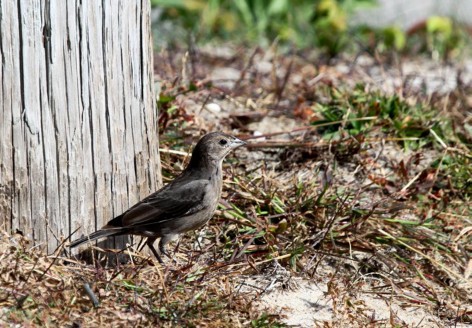David M. Larson

Female Brown-headed Cowbird. (Photograph by the author.)
The popular concept of brood parasites is of lazy cheats who dump eggs in other birds’ nests and scamper off on their merry way, leaving the poor suckers to take care of their eggs and young. Of course, the real story is much more complex. In the Old World, several groups of birds practice brood parasitism; some are obligate—they only breed this way—and others are facultative so brood parasitism is not strictly necessary. Obligate brood parasites can be generalists or can be restricted to a single host species. In Africa, for example, Variable Indigobirds only parasitize Jameson’s Firefinches, in which case the two species co-evolve as the host defenses change and the parasite catches up. In the New World, facultative brood parasites include cuckoos and several cavity-nesting ducks, while obligate brood parasitism is limited to cowbirds. And, of course, our North American exemplar is the Brown-headed Cowbird (Molothrus ater). This species is a generalist brood parasite, meaning that the female will lay an egg in the nests of a variety of host species. In fact, approximately 220 species of hosts have been documented, though only about 140 have fledged cowbirds (Lowther 1993).
Clearly, it is to the evolutionary advantage of cowbirds to select nests with a high probability of fledging young cowbirds. This selection could be based on habitats, nest locations, and host species. An open question has been if cowbirds are capable of learning which species to parasitize and even which nests to use. Louder et al. (2015) addressed this question as part of a long-term nest box project involving Prothonotary Warblers (Protonotaria citrea) in southern Illinois. Each year for 21 years, the researchers placed and monitored approximately 1000 standardized nest boxes for Prothonotary Warblers in suitable habitat. Prothonotary Warblers are good hosts for cowbirds since they apparently lack any defenses against these brood parasites (Hoover 2003). Although cowbird parasitism in these nest boxes was substantial—at least 60% of nests—the warblers often double-brooded and were capable of raising both cowbird and warbler nestlings in each nesting attempt.
The researchers predicted that fledging success for cowbirds in particular sites would increase the probability of cowbird parasitism during the following year—the cowbirds would remember and reinvest in successful locations. There was, in fact, a positive relationship between cowbird fledging in one year and the rate of parasitism in the following year. In nests with no cowbird fledging in year one, the rate of parasitism in year two was 49%. The rate was 72% for nests with cowbird fledging in year one, implying that the female cowbirds remembered and re-laid in nest boxes that successfully produced cowbirds.
In order to test if experimentally removing cowbird eggs would decrease the probability of parasitism in subsequent nesting attempts, a subset of nest boxes that had successfully fledged cowbirds had cowbird eggs removed from subsequent nests. The probability of parasitism dropped from 0.89 to 0.73 after eggs had been removed. Since the warblers are often double-brooded, the investigators could test the effects of egg removal from a first nesting on parasitism in the second brood. In this case, the probability of parasitism in the second brood dropped from 0.38 to 0.14 when the cowbird eggs were removed from the first brood.
So, the take-home message from this study is that female cowbirds, in their efforts to perpetuate their species, make choices about where to deposit their eggs based in part on knowledge of previous successes at sites and in particular nest boxes. This information is durable enough to inform laying decisions from year to year.
While personal observation of success seems the most parsimonious explanation, social communication of nesting success with conspecifics is also a possible learning mechanism.
Lest you think that brood parasitism is merely a matter of sneaking your eggs into another’s nest, you might be interested in an article that appeared in 2014 in Nature Scientific Reports where Chakra and colleagues reported on mafia-like behavior (Zahavi 1979) in Brown-headed Cowbirds and Great Spotted Cuckoos (Clamator glandarius). The authors started with the observation that when host species remove cowbird or cuckoo eggs from their nests, they face retaliatory attacks on the host’s young from the parasitic adults. Chakra and colleagues modeled this behavior using game theory and found a cyclic relationship, where retaliation by the parasite leads to cooperation from the host, leading to larger parasite populations. However, eventually inspection and retaliation becomes more rare and host populations begin more aggressive removal of the eggs of parasites. This cyclic interspecific behavior depends on the plasticity of host defenses against parasitism.
Thus, brood parasitism is not the simple dump and run proposition of folklore.
References
- Chakra, M. A., C. Hilbe, and A. Traulsen. 2014. Plastic Behaviors in Hosts Promote the Emergence of Retaliatory Parasites. Nature Scientific Reports 4: 4251.
- Hoover, J. P. 2003. Experiments and Observations of Prothonotary Warblers Indicate a Lack of Adaptive Responses to Brood Parasitism. Animal Behavior 65 (5): 935-44.
- Louder, M. I. M., W. M. Schelsky, A. N. Albores, and J. P. Hoover. 2015. A Generalist Brood Parasite Modifies Use of a Host in Response to Reproductive Success. Proceedings Royal Society London, Series B 282: 1615-22.
- Lowther, P. E. 1993. Brown-headed Cowbird (Molothrus ater). In the Birds of North America, No. 47 (eds. A. Poole and F. Gill), Ithaca, NY: Cornell Laboratory of Ornithology.
- Zahavi, A. 1979. Parasitism and Nest Predation in Parasitic Cuckoos. American Naturalist 113 (1): 157–9.
David M. Larson, PhD, is the Science and Education Coordinator at Mass Audubon’s Joppa Flats Education Center in Newburyport, the Director of Mass Audubon’s Birder’s Certificate Program and the Certificate Program in Bird Ecology (a course for naturalist guides in Belize), a domestic and international tour leader, Vice President of the Nuttall Ornithological Club, and a member of the editorial staff of Bird Observer.